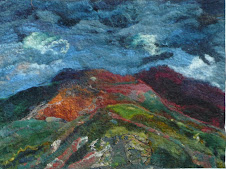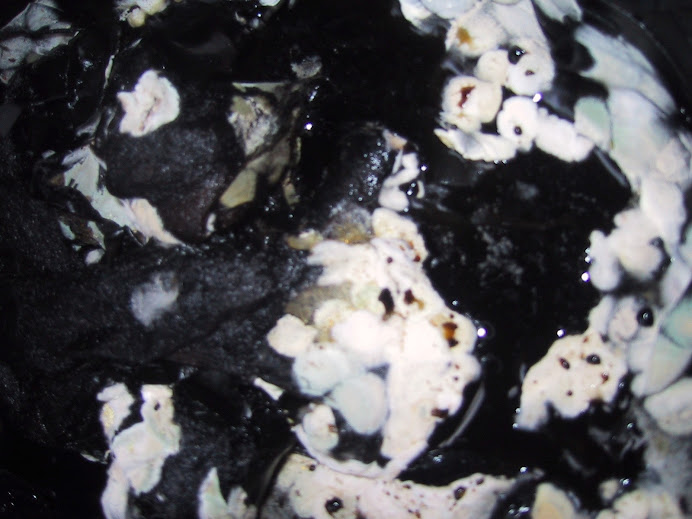
Well the purple loostrife has turned out a very pale grey on wool, a charcoal on silk. It was paler than I thought it would be as the bath is a black and seemed to be full of colour a little bit surprising. It could have been because the plant had really gone to seed so all the energy has gone into making the seeds , could have been because we had so little sun this summer. Could be because of course it contains very little dye. I will have to try and make sure I dye with it earlier next year.
My dh thought it was white.
Incidentally the yarn is not handspun by me but by Elaine Williams of Trefriw Woollen Mill who has a lovely dye garden. She is a very busy lady running a family business so sends me her handspun yarn and I dye it for her.
I have had an email from another dyer suggesting alder bark as a source of black. On reading about this I find it was a source of good blacks... a softer and bloomier black *......... not as harsh as some others, although it was considered destructive for fine wools, but of course it would be local ( the very name is considered celtic) and my source for much of this information Dominique Cardons book says that a silk dye works owned by Joshua Wardle in the 19th Centruy used bark cut in Cheshire, the county next to here. The bark has to be cut in spring and I would need to find a local source I am not sure I can cut bark form trees on someone else land.
A couple of weeks ago I adverised my indigo book the Colour of Sea and Sky, The Art of Indigo dyeing on natural dyes online and sold a lot of books very quickly. It s quite exciting to find them whizzing off to Australia, The Falkland Islands , Trinidad, Hawaii, Canada and the USA amongst others and I have a sense of invisible connecting lines linking us all to one another. Yesterday I got my first feedback, an Amercian Dyer sent me an account of her first days experience of using my instructions for the reduction bath-my favourite- she had a huge success with it and gives me a thrill to know that my instructions work adn the book has given pleasure too. An indigo vat is so much easier taught visually than anything else. Thats a thought maybe I could done on this blog .hmm
*Dominique Cardon Natural Dyes p 426



























is there anything more disappointing in natural dyeing than that moment, where you lift the fibres out, expecting a great colour from the dyebath - and then nothing is left after rinsing?:(( usually that happens to me with greens - when I put iron in, a dark green comes up - and hardly any of it is left on the yarn or fibre! of course sometimes it happens vice versa - yucky dyebath and the fibres turn out fine:)) though the light grey you achieved isn't ugly, but still... I started to cut up my frozen avocado skins and seeds - I hope I won't forget the heating part every couple of days.... they are all the brown "hass" variety - I am hoping for reds and burgundy tones!
ReplyDeleteThank you Helen, for an inspiring blog! I have read your madder posts before, but didn't have the courage to comment then, but now I do:) Reading about other peoples dye experiments and thoughts why everything happened the way they did just makes my fingers itch to start experimenting all kinds of things. There are so many things to try out... and time just flies.
ReplyDeleteLast summer I became a big fan of fermenting and dyeing in low temperatures, and was also very pleased with my madder colours in low temperatures.
Purple Loosestrife grows also here, I haven't tried it, but maybe next sumemr.
I have tried alder bark and have gotten beige or brownish yellow with alum and dark green with iron. I use very small amounts of iron, so maybe with more iron, the colour would be black? My alder barks were taken in summer, when a friend of mine cut them and dried the leaves for their sheep, like a "health food" for the winter. Maybe the colour would be darker, if they were cut in spring? We have lots of alders growing in our own land, I have to remember them in the spring.
I have heard that you can get black from nettles roots (Urtica dioica) but haven't tried them either. Last spring I dug some up and that was easy, but the yellow roots looked so small and all the dirt hard to wash from them, so I just threw them away. Well, I have plenty of nettles here (everywhere it shouldn't grow)so I have lots of material. That propably needs iron as well to get dark colour.
Best wishes
Leena from Finland